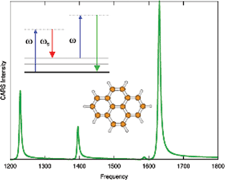Analytic ab initio calculations of coherent anti-Stokes Raman scattering (CARS)†
Abstract
We present a theory for the analytic calculation of frequency-dependent polarizability gradients, and apply the methodology to the calculation of coherent anti-Stokes Raman scattering (


 Please wait while we load your content...
Please wait while we load your content...